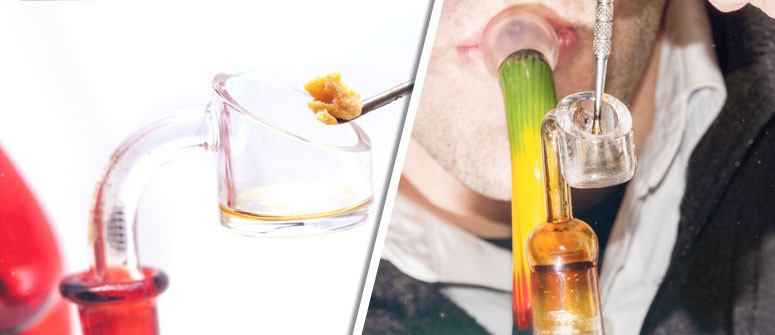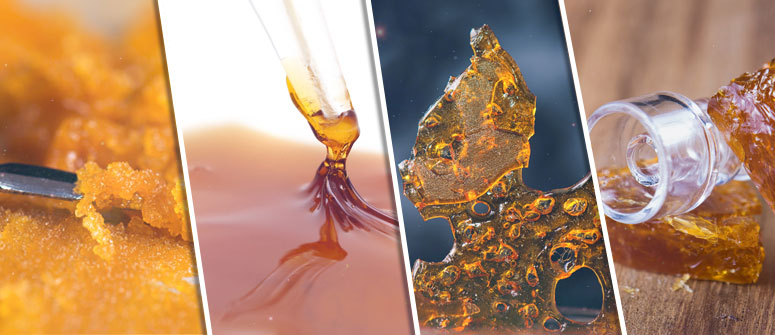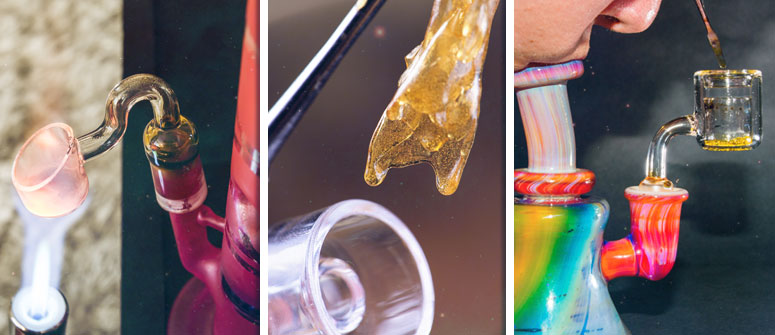What is dabbing, and how do you do it?

Nowadays, cannabis concentrates are available wherever you can find weed, and there are plenty of ways to take them. One of the most efficient and enjoyable, however, is known simply as dabbing. In this article, we'll show you exactly what we mean by "dabbing", detail the advantages and precautions, and show you how to take a dab yourself.
Contents:
It’s no secret that more and more people have started enjoying their cannabis in concentrate form. People often enjoy their oils and waxes in vape pens, as it allows them to get lifted on the go, but the original intake method emerged around a decade beforehand. Known plainly as “dabbing”, all you need is a special piece of glassware and some tools to enjoy heavy hits of concentrate like you’ve never experienced before.
WHAT IS DABBING?
To break it down simply, dabbing is the act of inhaling vaporized cannabis concentrate through a piece of glassware known as a dab rig. You can also use what’s known as a “Nectar Collector” or “dab straw”, but we’ll leave that discussion for another article.
The practice as we know it first began to take form around 2005, when a man who went by the name of BudderKing was interviewed for Cannabis Culture magazine. In the interview, he described a formula for making cannabis “budder”, which, at the time, was essentially cannabis concentrate left to partially solidify on the windowsill.
In that same interview, he showed off a glass device that could efficiently vaporize concentrates for swift inhalation. This became the first-ever prototype for what we know today as the dab rig.
It took time for these things to catch on, of course, but cannabis concentrates eventually met a public audience when they were included in the 2010 High Times Cannabis Cup. Upon reaching the international stage, dispensary operators began stocking concentrates and introducing customers to their wonders.
HOW DOES DABBING WORK?
Speaking of wonders, you may be wondering how dabbing actually works. It can seem like a science experiment when you see it for the first time, but it’s more straightforward than it initially appears.
At its core, dabbing involves heating up cannabis concentrate—which we’ll refer to mostly as “dabs” from this point on—and inhaling the vapor. Specifically, the dabs are vaporized as they’re placed in contact with your pre-heated apparatus. These mechanisms then allow you to directly inhale the vapor, and exhaling naturally completes the dabbing process.
WHAT DO YOU NEED TO DAB?
Sounds simple enough, right? Now that you know how it works, you’re one step closer to taking some dabs yourself! Here’s what you’ll need to acquire before you get started.
DAB RIG
As we brought up earlier, sourcing a dab rig is the first key step in the dabbing process. To those unfamiliar, dab rigs are bong-like glassware pieces specially outfitted for vaporizing dabs.
NAIL
What’s a nail, you wonder? Just as every bong has a bowl, every dab rig has a nail of some sort. The nail sort-of looks and functions like a bowl, except the opening is located on the side, rather than on the bottom.
It’s designed this way because you heat up the bottom when taking a dab, then literally dab your concentrate into the centre of the nail. You inhale as it evaporates, sending all the vapor through the opening on the side and into the rig itself.
The three most common materials used to make traditional (non-electronic) dab nails are titanium, glass, and quartz. Note that different types of nails will require a slightly different process, as the design of each nail can vary. For instance, instead of the opening being located on the side, some nails feature an opening protruding up from the middle. In turn, some require heating from directly below, while others are heated at an angle.
WAND / DABBER
Even if they weren’t sticky, we still wouldn’t suggest measuring out dabs with your fingers. As a much more effective alternative, you’ll want to grab what’s known as a dabber, dab tool, or wand. Those are steel scalpel-like tools you can use to cut off a dab and place it into your nail.
CARB CAP
As you take your dab, you’ll want to make sure none of that precious vapor escapes from the top opening. Thankfully, this potential problem is easy to solve; just place a carb cap on top of the nail. These will usually be made to fit right onto a standard nail, ideally staying in place without you needing to hold it there.
TORCH
While traditional lighter flames are definitely warm, they won’t do when trying to heat up your nail. Rather, you’ll need a butane torch (or non-butane alternative) to apply the necessary heat. In turn, you’ll need to regularly purchase cans of butane to refill it.
CANNABIS CONCENTRATE
You can't dab without the dabs themselves! Cannabis concentrates come in many forms, but dab rigs are best suited to enjoy certain types of hash or cannabis oil—which we'll explain in greater detail just below.

WHAT ARE CANNABIS CONCENTRATES?
We’ve been referring to cannabis concentrates as a sort-of vague monolith, but there’s a lot of diversity within the category.
BUTANE HASH OIL (BHO)
Butane hash oil, often referred to as just BHO, is a subset of concentrates distinguished by the use of butane as a solvent. Despite the potential issues that could come with butane, the process is completely safe and toxin-free in the right hands. In turn, because it’s cost-effective and efficient, it’s also the most common commercial extraction method out there.
SHATTER
One of the major subcategories of BHO, shatter is characterised by the fact that it will literally shatter in its cooled-down state. It has this texture because the cannabinoids, terpenes, etc. are mixed in a single phase, allowing light to pass through.
WAX
As the cannabis compounds get separated in concentrate form, however, they become a flaky, clay-like substance known as wax. Many claim wax tastes better than shatter, although it’s subjective, and their potency tends to be equal.
LIVE RESIN
Capping off the BHO category, live resin is marked by its unique preparation method. Instead of using dried and cured cannabis buds, live resin is made with fresh plant material that’s flash-frozen. This is mainly done to preserve the flavour and aroma, which tend to be much more pronounced with these concentrates.
ICE WATER HASH / BUBBLE HASH
Rather than utilising butane, ice water hash, otherwise known as bubble hash, involves extracting THC and other cannabinoids/terpenes using ice water and gradual filtration. You have to get it especially pure if you plan on dabbing it, though, as even small bits of plant matter can tarnish the experience.
ROSIN HASH
While you can dab especially purified hash, the best way to ensure it fully melts is by turning it into rosin. This is essentially done using heat and pressure, and there are many presses out there made explicitly for the process. This method is unique as it does not involve the use of a solvent—even water.
CO₂ OIL
Lastly, if you want to go for the purest experience of all, pick up some cannabis oil extracted using supercritical CO₂. It’s a thorough and efficient solvent involved, but the process is quite tech-intensive and costly in turn. As a result, these oils tend to be more expensive than others. That being said, you’ll be getting what you pay for.
HOW TO DAB CANNABIS CONCENTRATES
“Enough definitions, I’m ready to take a dab!”
We love the enthusiasm, but let’s make sure you have everything you need and know precisely what to do.
EQUIPMENT
To start, let’s quickly review the necessary equipment:
1. Dab rig
2. Nail
3. Dab tool/wand
4. Torch filled w/ butane
5. Carb cap
6. Cannabis concentrate of choice
DIRECTIONS
Taking a dab starts, of course, with measuring out your dab using your steel dabber. With the dab measured, you then heat up the bottom or side of the nail (depending on design) until it gets red-hot.
As the redness fades, lower your dab into the centre of the nail and begin inhaling as the dab starts to vaporize. When the dab is completely melted off the tool, remove it from the nail and place the carb cap over the opening. Once you’ve inhaled all the vapor, exhale as usual.

WHAT ARE THE BENEFITS OF DABBING?
Armed with the knowledge of how it’s done, it’s time to think about how dabbing actually stacks up in comparison to vaping or traditional smoking.
SMOOTHER ON THE LUNGS (WHEN DONE RIGHT)
To start, if you take your dabs at a lower temperature (waiting a little bit longer after the nail isn’t red anymore), the vapor will be much smoother on your lungs than standard weed smoke. It could even be smoother than a conventional vape, as many of those don’t have custom temperature settings. If you take your dab a bit too soon, though, it can irritate your throat as much as any puff from a joint or blunt.
MORE EFFICIENT THAN SMOKING
Since you’re enjoying a concentrate with around 60–80% THC, rather than buds with up to 30%+ THC at most, you only need a couple of hits to get as high as you would from a full joint. This also means you won’t have to do as much inhaling, and thus there’s less opportunity for your throat to get irritated.
TASTES BETTER
Since dabbing happens at a significantly lower temperature than smoking, you’ll find yourself able to detect more flavour nuances as well. See, if you were smoking the flower from which your dabs were made, the heat would burn off most of the terpenes. This heat also burns off cannabinoids, meaning you’ll get less high than if you dabbed the concentrate version.
FUN PROCESS
All of these benefits are great, yes, but we think one of the best parts about dabbing is the process itself. Heating up the rig with a torch? Placing the dab in the nail and covering the opening? Few other things make you feel more like a scientist without involving actual work.
IS DABBING SAFE?
We’ll end our discussion with the most important question of all: Is dabbing safe?
Well, when done right, the process is completely safe. Many people do it once or several times a day without incident, even when they’re already high. That being said, handling and lighting a butane torch always comes with risks that need to be considered beforehand.
Make sure you don’t try dabbing if you’re already too high, as lighting the torch or aiming at the wrong spot can be a costly and harmful mistake. In turn, since burns are possible, be sure to not touch the nail for 10 minutes after your last dab.
Other than that, it’s just as safe as regular smoking. Just pay attention to yourself during the process, and enjoy your dabs!




